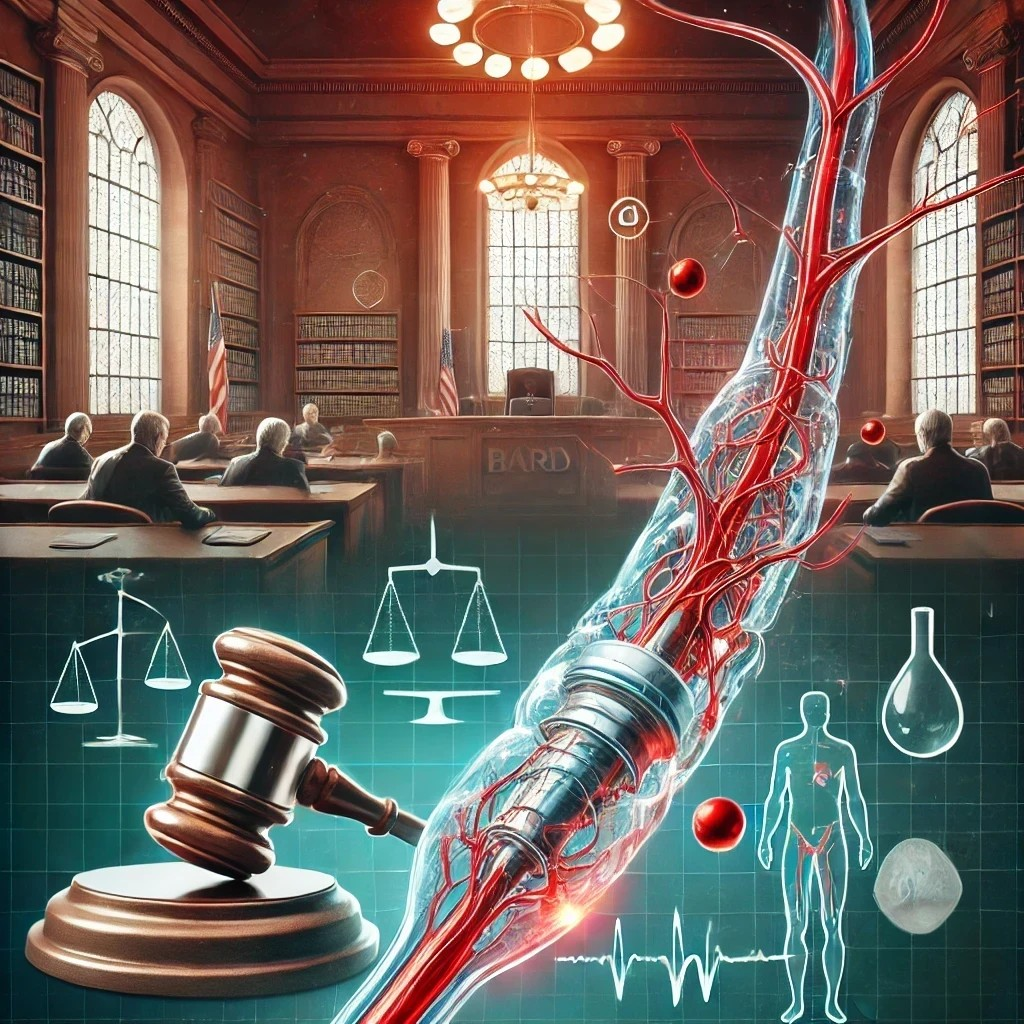The Bard catheter controversy has brought to light serious concerns about the safety of Bard PowerPort devices. Manufactured by Bard Access Systems, Inc., a subsidiary of Becton, Dickinson and Company, these implantable catheter devices, known as Bard PowerPorts, are designed to provide long-term access to a patient’s vascular system for medical treatment such as blood draws, chemotherapy, and intravenous fluids. However, a growing number of patients have reported severe complications, including catheter fractures, infections, and blood clots, leading to a wave of Bard PowerPort lawsuits. Ongoing legal cases related to the Bard Power Port highlight alleged complications and defects, emphasizing the lack of transparency from the manufacturers.
Plaintiffs in these lawsuits allege that Bard, Inc. failed to adequately warn patients and healthcare providers about the risks associated with its PowerPort models, including the Bard PowerPort catheter and Bard PowerPort catheters. Issues such as device fracture, catheter migration, and bloodstream infections have resulted in life-threatening complications for many patients. With multidistrict litigation (MDL 3081) underway, affected individuals are seeking compensation for medical expenses, surgical interventions, and persistent pain caused by defective Bard PowerPort devices, including the Bard PowerPort implant. The Bard PowerPort multidistrict litigation aims to streamline pretrial proceedings for these cases.
Mass Tort America is here to provide legal assistance for those impacted by Bard PowerPort injuries. With a dedicated team of lawyers, we are ready to guide you through the complexities of these lawsuits. Contact us today for support with your Bard PowerPort lawsuit. Plaintiffs’ Bard PowerPort lawsuit allegations include claims of negligence and failure to address known risks. One Bard PowerPort lawsuit alleges that a Kansas woman experienced serious complications after receiving a Bard PowerPort implant, highlighting the defendants’ failure to inform her and her healthcare providers about the known risks.
Bard, Inc. and Its History Of Controversy
C. R. Bard, Inc. has a long history of controversy surrounding its medical devices. In 2006, the company faced accusations of paying illegal kickbacks to physicians and consumers, leading to a $48.26 million settlement in 2013. Additionally, Bard’s vaginal mesh devices have been linked to serious injuries and complications, resulting in thousands of lawsuits and a settlement exceeding $200 million. The company’s inferior vena cava (IVC) filters have also been associated with fatalities and non-fatal problems, culminating in a court-ordered payment of $1.6 million in damages and $2 million in punitive damages in 2018. These past issues highlight a troubling pattern of behavior that continues with the current Bard PowerPort controversy, raising questions about the company’s commitment to patient safety and product quality.
What Is The Bard PowerPort Device?
The Bard PowerPort device is a sophisticated implantable port catheter system designed to facilitate repeated access to the vascular system for the administration of medications, intravenous fluids, parenteral nutrition solutions, and blood products. Manufactured by Bard Access Systems, Inc., a subsidiary of Becton, Dickinson and Company, the device is engineered to streamline medical treatments that require frequent vascular access.
The Bard PowerPort device consists of a durable titanium or plastic housing equipped with a silicone septum, which allows for easy medication access. The system also includes catheters that deliver fluids and enable blood withdrawal. Typically implanted under the skin on the chest or arm, the device connects to a large central vein, ensuring that medications and other treatments are efficiently delivered into the bloodstream. This design aims to reduce the discomfort and complications associated with repeated needle sticks, making it a preferred choice for patients undergoing long-term treatments.
The Design And Intended Use Of Bard PowerPort Devices
Bard PowerPort devices are implantable port catheters designed to simplify the administration of medical treatments. These devices feature an injection port connected to a catheter body, which is typically made from polyurethane and barium sulfate. The design allows for easy access to blood vessels, reducing the need for repeated needle sticks during treatments like chemotherapy or frequent blood draws.
Despite their intended benefits, Bard PowerPort models have been linked to significant risks. The device’s mechanical properties, particularly the inclusion of barium sulfate, may weaken the catheter over time, making it prone to fractures. This can lead to pieces of the catheter migrating through the bloodstream, causing serious injuries such as blood clots and deep vein thrombosis (DVT).
For patients, these complications often result in the need for multiple surgeries to remove fractured catheter parts and repair damage to blood vessels. In severe cases, the injuries caused by defective Bard PowerPort devices have been life-threatening, prompting numerous lawsuits against Bard Access Systems, Inc.
Common Bard PowerPort Complications Associated With Bard PowerPort Devices
Patients have reported a range of serious complications associated with Bard PowerPort implants. One of the most common issues is catheter fracture, where the device breaks apart, releasing fragments into the bloodstream. This can lead to dangerous conditions such as pulmonary embolism, where blood clots block blood flow to the lungs, requiring immediate medical attention.
Infections are another frequent complication, often originating at the port catheter insertion site. These infections can escalate to bloodstream infections, posing significant risks to patient safety. Persistent pain around the implanted port catheter is also a common complaint, often requiring further surgical intervention to address the issue.
Other complications include catheter migration, where the device moves from its original position, potentially perforating nearby tissues or organs. These serious complications highlight the risks associated with Bard PowerPort devices and have been central to the ongoing product liability lawsuits.
Symptoms To Watch For
If you have a Bard PowerPort implantable port, it is crucial to be vigilant about potential symptoms and complications that may arise. Being aware of these signs can help you seek timely medical intervention and prevent further issues. Common symptoms to watch for include:
- Localized pain or discomfort at the port site
- Visible protrusion or displacement of the port
- Difficulty flushing or accessing the port
- Shortness of breath or difficulty breathing
- Chest pain or discomfort
- Swelling, redness, or warmth at the port site
- Fever or chills
- General malaise or feeling unwell
Experiencing any of these symptoms warrants prompt consultation with your healthcare provider to address potential complications and ensure your safety.
Allegations In Bard PowerPort Lawsuits
Bard PowerPort lawsuits allege that Bard, Inc. and its parent company, Becton, Dickinson and Company, failed to adequately test their implantable port catheters before releasing them to the market. Plaintiffs claim that the devices were prone to defects, such as fractures and migration, and that Bard continued to sell them despite knowing about these risks.
Adverse event reports submitted to regulatory agencies revealed a pattern of complications linked to Bard PowerPort devices. These include significant risks like device fracture, severe and persistent pain, and other complications that required surgical intervention. Plaintiffs argue that Bard Access Systems, Inc. should have recalled the defective devices to protect patient safety.
The lawsuits also highlight the failure to warn healthcare providers and patients about the potential dangers of using Bard PowerPort models. These allegations have become a focal point in the ongoing multidistrict litigation (MDL 3081), with plaintiffs seeking accountability and compensation for their injuries.
The Role Of Multidistrict Litigation
In 2023, the Judicial Panel on Multidistrict Litigation consolidated Bard PowerPort cases into MDL 3081, presided over by U.S. District Judge David G. Campbell in Arizona. This legal process is designed to streamline pretrial proceedings by addressing common issues across the lawsuits, such as product liability allegations and adverse event reports.
As of October 2024, more than 521 Bard PowerPort lawsuits have been included in the MDL, with more expected as awareness of the device’s risks grows. Bellwether trials, scheduled for 2025, will serve as test cases to determine how juries respond to the evidence presented. The outcomes of these trials could influence whether Bard chooses to settle or continue litigating these cases.
The MDL structure allows plaintiffs to maintain individual claims while benefiting from the efficiency of consolidated pretrial proceedings. This process is critical for addressing the widespread issues associated with defective Bard PowerPort devices.
The 2020 Bard PowerPort Recall
In March 2020, the U.S. Food and Drug Administration (FDA) announced a Class 2 recall for three Bard PowerPort models. The recall was initiated due to the risk of incorrectly containing a tunneler with a barb tip meant to attach to a 6Fr catheter instead of the correct barb tip for a 9.6Fr catheter. This discrepancy could result in prolonged surgical procedures and potentially cause minor tissue injury to patients. The recall underscores the importance of ensuring that all components of medical devices meet the required specifications to prevent patient harm.
Risks Linked To Bard PowerPort Devices
The risks associated with Bard PowerPort devices go beyond the typical complications of implantable catheter devices. Reports have linked these devices to severe injuries such as catheter fractures, blood clots, and bloodstream infections. These complications not only disrupt medical treatment but also pose a significant risk to patient safety.
For example, catheter fractures often require surgical intervention to remove fragments that have migrated to other parts of the body. Such procedures carry their own risks and can lead to prolonged recovery times and additional medical expenses. Similarly, infections originating from the implanted port catheter can escalate quickly, necessitating immediate medical attention.
Patients and their families have voiced concerns about Bard’s handling of these issues, particularly the lack of transparency regarding the device’s risks. This has fueled the ongoing lawsuits, as plaintiffs seek justice for the harm caused by these defective medical devices.
Alleged Design Flaws In Bard PowerPort Devices
A central issue in the Bard PowerPort lawsuits is the alleged design flaws in the device. The catheter’s use of polyurethane and barium sulfate is meant to enhance its visibility during imaging procedures. However, plaintiffs argue that these materials compromise the catheter’s mechanical properties, making it prone to device fracture and other complications.
The lawsuits claim that Bard Access Systems, Inc. did not conduct sufficient testing to identify these flaws before releasing the devices. As a result, patients have experienced serious complications, including blood clots, persistent pain, and deep vein thrombosis. These issues have raised questions about Bard’s commitment to patient safety and product quality.
The bellwether trials will play a key role in determining whether Bard can be held accountable for these design flaws. The outcomes may also influence the future of other lawsuits involving defective medical devices.
Impact on Patients And Healthcare Providers
For patients, the complications associated with Bard PowerPort devices have been devastating. Many have endured multiple surgeries, prolonged hospital stays, and significant financial strain due to mounting medical bills. The physical and emotional toll of these injuries cannot be understated, as patients struggle to regain their quality of life.
Healthcare providers have also faced challenges in managing the risks posed by defective Bard PowerPort devices. The need for immediate medical attention to address complications such as pulmonary embolism or bloodstream infections has placed additional burdens on already strained medical systems.
These widespread impacts underscore the importance of holding medical device manufacturers like Bard Access Systems accountable for ensuring the safety and reliability of their products.
Damages And Settlements In Bard PowerPort Lawsuits
The Bard PowerPort lawsuits allege that the device is defective and has led to severe injuries and complications, including blood clots, deep vein thrombosis, and catheter migration. Plaintiffs in these lawsuits may be entitled to various forms of compensation, such as:
- Medical expenses
- Lost wages
- Pain and suffering
- Emotional distress
- Loss of enjoyment of life
- Loss of consortium
- Wrongful death
The average settlement amount for Bard PowerPort lawsuits is anticipated to exceed $300,000, with some claims potentially reaching over $1 million. These settlements aim to compensate for the significant physical, emotional, and financial burdens caused by the defective devices.
Why Choose Mass Tort America For Bard PowerPort Cases?
At Mass Tort America, we are dedicated to helping patients affected by defective Bard PowerPort devices. Our experienced legal team understands the challenges you face and works tirelessly to secure the compensation you deserve. Whether you’ve experienced blood clots, persistent pain, or other complications, we are here to assist.
We offer personalized legal support and a concierge team to coordinate every step of your case. If you’ve been impacted by Bard PowerPort complications, contact us today at 800-356-4338 or through our contact form at https://masstortamerica.com/contact/. Let us help you seek justice and hold Bard Access Systems accountable.

















